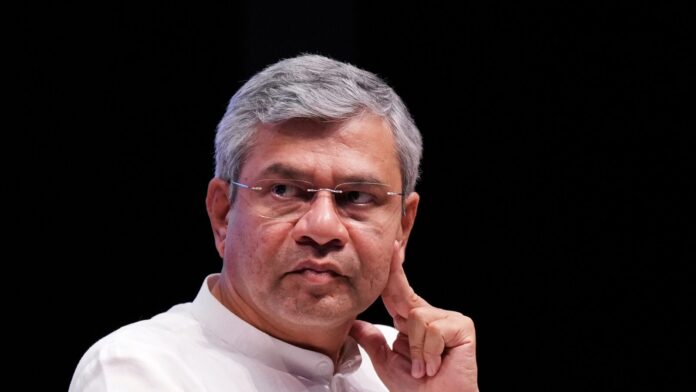The four companies—Amber Enterprises, Kaynes Technology, SRF and Syrma SGS—said on the sidelines of a press briefing by Meity on Monday that production of printed circuit boards (PCBs), camera module sub-assemblies, high-density connectors and other components will begin as early as mid-2026.
On Monday, Union IT minister Ashwini Vaishnaw announced seven projects by these companies as the first tranche of approved component manufacturing initiatives under the ₹22,919-crore electronics components manufacturing scheme (ECMS). The scheme accepted applications until 30 September. On 2 October, Vaishnaw had said that the scheme received twice the expected investment volume, at ₹1.15 trillion, spread across 249 applications.
The approved investments— ₹5,532 crore—represent roughly 5% of the net investments the minister had cited earlier this month. “Overall, the first tranche of investments will cater to 20% of India’s domestic demand for PCBs, and 15% of all camera module sub-assemblies that are needed in the country,” Vaishnaw said at the media briefing.
The ECMS scheme offers project-based incentives of up to 25% of capital expenditure, up to 6% of annual turnover, or both. A senior government official told Mint on the sidelines of a roundtable on Monday that the Centre’s approach with ECMS is to roll out incentives based on completion of projects.
Who benefits from the scheme
Bengaluru-based Kaynes Technology was the biggest beneficiary of Monday’s approvals, accounting for four of the seven cleared projects. The company will make a cumulative investment of ₹3,280 crore in making multi-layer PCBs, camera module sub-assemblies, high-density connector boards and copper laminates from a wholly owned subsidiary’s Tamil Nadu plant.
Ramesh Kannan, managing director of Kaynes, said production will begin by mid-2026 for all of the four components. “We’ve already begun work on establishing the factories, and each of these components are critical parts of various electronics across consumer and enterprise categories,” Kannan said.
He added that the move is a step further toward expanding the company’s operating margin, “and the Centre’s incentives will further expedite our ability to do so”. However, Kannan did not offer a revenue projection, citing a silent period ahead of the company’s September quarter earnings.
Jasbir Singh Gujral, managing director of Chennai-headquartered Syrma SGS, concurred with Kannan. “The Centre’s subsidies will certainly help with our goal of stepping up electronics margins, which we’re already expecting,” he said. “We’re looking at a timeline of as early as the first quarter of the next fiscal year to start production of multi-layer PCBs from a new production line.”
Apart from Noida-headquartered Dixon Technologies, Kaynes Technology, Syrma SGS, and Gurugram-based SRF Ltd and Amber Enterprises are four of India’s top five electronics manufacturing services (EMS) firms.
A leg-up to local manufacturing
The sector has largely relied on electronics assemblies over the past decade. Industry experts said that venturing into component manufacturing will be key to expanding the wafer-thin margins that electronics assemblies typically offer.
“We expect component forays to ensure customer stickiness and boost margin profiles, offsetting the impact of the discontinuation of the mobile incentives scheme by the Indian government from FY27,” Nirransh Jain, research analyst at brokerage firm BNP Paribas, said in an investor note on 8 October.
While Dixon Technologies, India’s largest EMS firm, was not among the approved list on Monday, the company said in its post-earnings analyst call on 17 October that it will also bet on component localization in the coming quarters—for both revenue and margin growth.
Where’s the demand?
Kannan and Gujral said initial demand for the components they are respectively targeting are accounted for by existing clients themselves. “We’ve already received massive expressions of interest from our existing electronics assembly clients,” Kannan said. “We will look at exports too—about 20% of our revenue is driven by exports, and the same will hold true for components, too.”
Gujral added that domestic demand is very strong, and there is a good opportunity to ramp-up local value addition across all electronics segments.
“As a result, our initial production will almost entirely cater to local clients,” Gujral said. “As and when we ramp-up further capacity, we’ll also export the components we produce.”
For now, though, raw material supplies will remain dependent on imports. “We have a stable relationship with our suppliers, but we’ll of course rely on imports for the time being. In the long run, our goal is to localize raw material sourcing as well, which we will perhaps seek to do from FY28 onwards,” Kaynes’ Kannan added.
domestic electronics manufacturing,electronics components manufacturing scheme,printed circuit boards,camera module sub-assemblies,Kaynes Technology,ashwini vaishnaw electronics push,india electronics manufacturing 2025,electronics components scheme
#Kaynes #Amber #SRF #Syrma #win #nod #22919cr #electronics #components #scheme #roll #local #parts #mid2026

